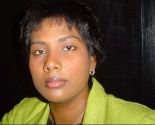Caribbean Census Bill Not A Race Category
NEW YORK – The Caribbean Census bill introduced in the Congress by Congresswoman Yvette Clarke on April 23rd is not a push for a race category but one for an accurate self-identifying ancestry category, CaribID officials insisted Monday.
The clarification comes in response to a number of media reports that erroneously reported that the bill is a call for a race category and therefore is a move to divide some ethnic groupings, particularly the African American or black bloc.

Felicia Persaud
CaribID founder, Felicia Persaud, insisted that the bill is to enable Caribbean nationals, who are of varied races, cultures and identities across the 26 countries in the Caribbean region to not only tick their race group on the Census forms, but like Hispanics, be able to tick their ancestry as well.
FACTS & MYTHS ABOUT THE CARIBBEAN CENSUS BILL
Myth
It’s to divide the black community.
Fact
Wrong! This is not about race. It will not divide any one group but help boost the Caribbean census count while also allowing people to accurately self-identify their origin and race simultaneously and helping this bloc to be truly counted and not ignored as invisible as it is now. It’s about ensuring an accurate count of this growing population that has been here since slavery and ensuring we’re getting back what we’re paying out in dollars to our communities to answer our specific needs that are distinct in many ways from African Americans or other ethnic groups.
Myth
Caribbean people are all black.
Fact
The Caribbean is a multiplicity of races, cultures and nations that are bandied together and united because of their region of birth – the Caribbean. The varied races include White, Black, Chinese, Indo-Caribbeans, Portuguese, Caribs, Amerindians and every mixture between.
Most are from: the French, Dutch, Spanish and English-speaking Caribbean nations, including: Anguilla, Antigua & Barbuda, Aruba, The Bahamas, Barbados, the British Virgin Islands, the Cayman Islands, Cuba, Dominica, the Dominican Republic, Grenada, Guyana, Guadeloupe, Haiti, Jamaica, Martinique, Montserrat, the Netherlands Antilles, St. Kitts-Nevis, St. Lucia, St. Vincent & the Grenadines, Suriname, Trinidad & Tobago and the Turks and Caicos Islands.
Caribbean Blacks are differentiated from African Americans by cultural values/customs, languages and ethnicity for some.
Myth
Caribbean people just got off the boat.
Fact
Caribbean people have been here since history. Alexander Hamilton (January 11, 1755 or 1757 – July 12, 1804) was the first Secretary of the Treasury, a Founding Father, economist, and political philosopher.
Mary Prince, a West Indian Slave was brought to the U.S. in 1831. And nationals and Caribbean Americans were among the many who contributed vigorously to the movements for black power and to civil rights in the U.S., and unlike what many Americans may feel, did not simply arrive from the Caribbean in recent years.
There was also Jamaican national Marcus Mosiah Garvey, Jr., whose beliefs inspired many to push forward the rights of blacks across the U.S. and the world.
And Garvey was not alone in his contribution to the Black rights struggle. Trinidadian Stokely Standiford Churchill Carmichael, also known as Kwame Ture, rose to prominence first as a leader of the Student Nonviolent Coordinating Committee and later as the “Honorary Prime Minister” of the Black Panther Party during the civil rights era. Initially an integrationist, Carmichael later became affiliated with black nationalist and Pan-Africanist movement.
Others like Claude Mckay, a Jamaican writer, were part of The Harlem Renaissance, which included Afro-Caribbean artists and intellectuals from the British West Indies, who had migrated to New York in number.
So too did Eulalie Spence, the Nevis-born black, female writer, teacher, actress and playwright, who came to the United States in 1902. In legal circles, who can forget Constance Baker Motley, born to parents from Nevis. Motley Baker went on to become the first black woman elected to the New York State Senate, the first woman who was Manhattan Borough President and the first black federal court judge, named in 1966 to the post by President Lyndon Johnson. But most of all, she is remembered for writing the original complaint in the case of Brown v. Board of Education in 1950.
She was also the first African-American woman ever to argue a case before the U.S. Supreme Court, in Meredith v. Fair she successfully won James Meredith’s effort to be the first black student to attend the University of Mississippi. Motley was successful in nine of the ten cases she argued before the Supreme Court. The tenth decision, regarding jury composition, was eventually overturned in her favor. She was otherwise a key legal strategist in the civil rights movement, helping to desegregate Southern schools, buses, and lunch counters.
And Joseph Sandiford Atwell, a Barbadian in 1867 became the first black man after the Civil War to be ordained in the Episcopal Church in the United States.
Among the sons and daughters of this first generation of Caribbean migrants is a phalanx of distinguished Afro-Americans: Malcolm X, Louis Farrakhan, Harry Belafonte, Colin Powell, St. Clair Drake, Clifford Alexander, Bruce Llewelyn, Cicely Tyson, Maida Springer Kemp, Vincent Harding, Robert Moses, Shirley Chisholm, Constance Baker Motley, Mamie Phipps Clark, Margaret Walker, Kareem Abdul-Jabbar, Audre Lorde, Michelle Wallace, Paule Marshall, Yaphet Kotto, Sonny Rollins, Rosa Guy, June Jordan, and Lani Guinier.
Caribbean nationals who entered Ellis Island in the early 1900’s are among those whose photographs have been immortalized at the island`s museum.
Among the earliest identified were two unnamed women from Guadeloupe, who arrived in the U.S. in 1911. Jamaican immigrant Patrick Warrick Codner arrived with his wife and family in the early 1920`s, according to records while little Viola Lewis came to New York in 1924 to join her parents from Barbados.
Hilda Gumbs Fenwick also arrived in New York from Trinidad & Tobago in 1924, museum records state while little Muriel Patrick also came from T&T with her family, but in 1919 and little Viola Lewis in 1917.
That same year, Edwin Belfield Lewis, a native of Barbados, had arrived at Ellis Island as well.
Meanwhile, the first Caribbean-born baseball players have also made it into the exhibit of foreign-born players at the museum. Among them are Aruba`s Gene Kingsale, the Bahamas` Andre Rodgers, Jamaica`s Chile Davis and the Virgin Islands` Joe Christopher.
Why This Category?
Caribbean nationals are growing at a rapid pace yet they have no accurate numbers that speak of their existence in the U.S. As such our specific issues cannot be truly addressed, our businesses cannot grow, our media is stagnant – all because we have no real facts or hard numbers. Everything starts with the Census and its accuracy is important for political and economic empowerment.
Being black or Asian and or Caucasian will not change simply because you tick Caribbean as an ancestry. Especially since people will tick both and simply enhance the details of the data collection process. The bill introduced by Congresswoman Yvette Clarke simply and precisely calls for this ancestry identifying category to ensure that our community gets the accurate numbers it needs to measure its economic contribution, spending power, voting power, etc so its specific needs can be served. It’s a simple fact of what the Census does. This niche bloc maintains connections to their friends and family in their native countries as well as maintain ties to native traditions, including food, music, and entertainment. Yet their numbers are not known and they show up nowhere on the radar of where it counts.
`We want back what we’re putting in through millions of tax dollars. It`s about economics and politics not about divide and rule,` said Persaud.
For more on Carib ID log on to www.caribid2010.com.

